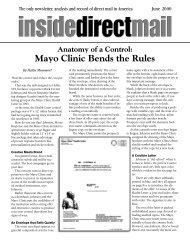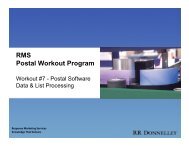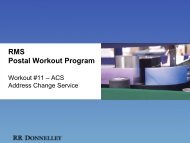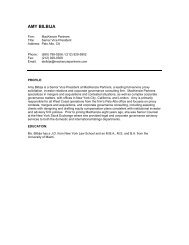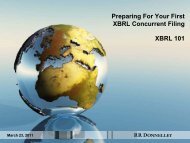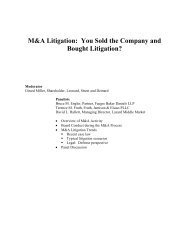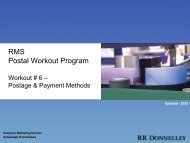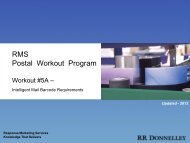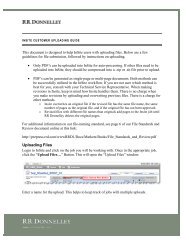Download - RR Donnelley
Download - RR Donnelley
Download - RR Donnelley
Create successful ePaper yourself
Turn your PDF publications into a flip-book with our unique Google optimized e-Paper software.
Preparing for Detail Footnote Tagging<br />
XBRL 102<br />
March 24, 2011
A Few Webcast Reminders<br />
• Content<br />
• Session material and link to replay of webcast will be sent to you via email within a few<br />
days of today’s event<br />
• Questions<br />
• Do not hold questions until the end, as many submitted questions as possible will be<br />
answered during the webcast<br />
• Type in your questions on the web interface<br />
• Follow-Up<br />
• Speakers are available directly for material not covered or questions not addressed<br />
during today’s webcast<br />
1
Presenters<br />
Rob Blake<br />
Senior Director,<br />
Interactive Services<br />
<strong>RR</strong> <strong>Donnelley</strong><br />
rob.blake@bowne.com<br />
Julie Soma<br />
XBRL Specialist, National<br />
EDGAR and XBRL Team<br />
Member<br />
<strong>RR</strong> <strong>Donnelley</strong><br />
julie.soma@rrd.com<br />
<br />
<br />
<br />
Founding member of<br />
XBRL International<br />
Develops software and<br />
solutions strategy for<br />
XBRL<br />
Led US GAAP<br />
taxonomies and SEC<br />
XBRL Viewer projects<br />
<br />
<br />
Lead on client<br />
education and internal<br />
XBRL training<br />
initiatives<br />
SEC and Vendor lead<br />
for strategy, Best<br />
Practices, and service<br />
offering enhancements<br />
2
Word on the Street<br />
• Filing Agents and/or their XBRL partners can’t turn edits quick enough<br />
• XBRL knowledge requirements for detail tagging are too intense<br />
• Too much pressure on making concurrent filing; SEC needs to provide more<br />
time to submit XBRL documents<br />
• Switching from one taxonomy (2009) to another (2011) is onerous and time<br />
consuming<br />
• Rendered XBRL for detail tagging is impossible to review and approve<br />
• Errors show up on my XBRL filings on 3 rd party validation sites like<br />
XBRLCloud and yet the SEC accepted them<br />
3
Agenda<br />
• SEC Update and Overview of Year 2 Tagging Requirements<br />
• Market Statistics and Impact of XBRL on Filing Timeline<br />
• Common Issues and Validation Conundrum<br />
• Dimensions: Detail Tagging Make or Break<br />
• <strong>RR</strong> <strong>Donnelley</strong> Solution Offerings<br />
• Planning for Detail Tagging and Schedule Considerations<br />
• Impact of 2011 US GAAP Taxonomy<br />
• Q&A<br />
4
Detail Tagging Reality Check<br />
• 4-10x more work<br />
• 2-4x more resources<br />
• 3-6x more extension tags<br />
• Increased XBRL understanding<br />
• Increased technical validation risk<br />
• Increased filing season pressure<br />
• Increased pressure on self-taggers<br />
While difficult and more time consuming than<br />
block (Year 1) tagging, detail tagging is<br />
approachable with the right plan and partners.<br />
5
Phase-In Reminders<br />
Tier 1<br />
>$5B Large<br />
Accelerated Filers<br />
(~450 companies)<br />
Tier 2<br />
Remaining LAFs<br />
>$700M,
EDGAR Filer Manual<br />
SEC XBRL Update<br />
• Vol. II Ver. 16<br />
• Finalized and released in December 2010<br />
• 5 th update since start of XBRL mandate; more expected to come<br />
Staff Observations/FAQs<br />
• FAQs updated and reformatted September 2010<br />
• New Staff Observations November 2010<br />
XBRL Rendering Engine<br />
• Updated in July and November 2010<br />
Taxonomies<br />
• 2011 US GAAP Approved February 2011<br />
• Removed requirement to file submissions on/after 7/15/2011<br />
• SEC strongly recommends companies use it as soon as possible<br />
• Available for review on FASB web site (wwww.fasb.org)<br />
7
Level 1: Face Statement Tagging and Process<br />
Find Tag<br />
Evaluate US GAAP Taxonomy<br />
Create Extension Tag<br />
Must create all required attributes:<br />
If the tag’s definition<br />
includes the material<br />
amounts, and its other<br />
attributes align, it’s the<br />
right tag; if not, then an<br />
extension tag is needed.<br />
…as well as assign presentation, calculation<br />
and definition (dimension) relationships.<br />
8
Level 2: Significant Accounting Policies (SAP)<br />
Tag<br />
Significant: Tag regardless of location<br />
Insignificant: Tag only if in SAP<br />
Structure: Group in one report section<br />
9
Level 3: Table Block Tagging<br />
• Each table tagged as block of text<br />
• Tables split by time tagged as one<br />
• A single table with multiple pieces can be tagged<br />
individually<br />
Tag<br />
10
Level 4: Detail Amount Tagging<br />
Tag<br />
• Any amount (not just numbers)<br />
• Not all numbers need tagged (but most do)<br />
• Important to review amounts and determine tagability<br />
• Presentation in XBRL will most likely not match HTML<br />
11
Detail Tagging Extension Taxonomy Architecture<br />
Accounting<br />
Policies (Level 2)<br />
Only one (Policies) XBRL report<br />
section is allowed.<br />
Block Table<br />
Tagging (Level 3)<br />
Schedules are not table-block<br />
tagged.<br />
Split up largest Notes into<br />
smaller report sections,<br />
essentially breaking them out<br />
one XBRL report section per<br />
table; helps SEC Viewer<br />
render reports better.<br />
Amount Detail<br />
Tagging (Level 4)<br />
12
Display in SEC Viewer: Okay To Be Different<br />
Data without<br />
dimensions is<br />
presented first,<br />
including “Total” rows<br />
from dimensionally<br />
tagged data.<br />
Data with dimensions<br />
is presented second.<br />
13
<strong>RR</strong> <strong>Donnelley</strong>: The XBRL Leader<br />
XBRL Market<br />
Leadership and<br />
Expertise<br />
Service Platform and<br />
Unmatched Scale<br />
Technology for<br />
Efficiency and<br />
Accuracy<br />
• 5x the filings of our<br />
nearest competitor<br />
• Deep experience in<br />
every industry<br />
segment<br />
• Broadest, deepest<br />
team of XBRL /<br />
EDGAR experts in<br />
the industry<br />
• Team of over 1,000<br />
dedicated to XBRL<br />
• Multiple platforms<br />
provide flexibility and<br />
scale<br />
• Client service DNA<br />
• Dedication to<br />
process improvement<br />
and QA<br />
• Combination of<br />
owned and licensed<br />
tools for tagging,<br />
review and validation<br />
• Continued<br />
investment in<br />
proprietary tools<br />
• Deep understanding<br />
of client workflow<br />
guides development<br />
14
Total Company Extensions<br />
15
Extension % By SIC – Tier 1/Detail Tagging<br />
SIC<br />
Q2<br />
2010<br />
Q3<br />
2010<br />
Q4<br />
2010<br />
Construction 33.74 38.13 26.95<br />
Finance, Insurance & Real Estate 44.03 43.05 43.98<br />
Manufacturing 27.42 28.25 31.33<br />
Mining 30.78 32.04 34.27<br />
Retail Trade 21.06 23.29 28.01<br />
Services 26.06 26.65 29.67<br />
Transportation, Communication, Electric,<br />
Gas, and Sanitary Services<br />
39.18 40.23 39.60<br />
Wholesale Trade 23.48 17.24 24.39<br />
Average 32.76 34.29 35.61<br />
16
Impact on Last Day Filings<br />
17
Dimensions Overview<br />
Accounting Information<br />
Dimension Information<br />
Calendar Information<br />
A majority of Year 2 tagging relies on the<br />
combination of a “simple” tag in<br />
conjunction with one or more<br />
“dimension” tags to correct identify all<br />
facets of the data.<br />
18
Accounting Information<br />
Dimension Information<br />
Calendar Information<br />
Multi-dimensional Tagging: Basic Tag<br />
19
Accounting Information<br />
Dimension Information<br />
Calendar Information<br />
Multi-dimensional Tagging: Dimension Tag<br />
20
Accounting Information<br />
Dimension Information<br />
Calendar Information<br />
Multi-dimensional Tagging: Extension Taxonomy<br />
21
SEC<br />
SEC vs. Third Party Validation<br />
• EFM contains over 600+ rules covering both technical and business aspects<br />
• Validation today focuses primarily on technical and “basic” business concepts<br />
• SEC not updating validation bar in short/mid-term (subject to change of<br />
course)<br />
Third Party<br />
• Being performed in the market (e.g., XBRLCloud)<br />
• Passing SEC validation does NOT mean filings are necessarily as clean as<br />
they should be<br />
• Company ultimately decides if they care about “beyond SEC” validation<br />
• Recommendation: Care (at least a little).<br />
22
Third Party Validation<br />
1. All filings passed<br />
SEC validation or<br />
they wouldn’t<br />
display<br />
2. Combination of<br />
errors/warnings<br />
above and beyond<br />
what SEC is<br />
checking for<br />
currently<br />
3. Detail tagging<br />
submissions with<br />
issues stand out<br />
due to higher<br />
numbers in<br />
multiple columns<br />
23
• Improper Use of Tag Properties<br />
• Instant tags for durational data<br />
• String tags for block-tagged data<br />
Most Common Issues – Detail Tagging<br />
• Not using same tags for the same values/accounting representations across notes<br />
• Tag Percentages<br />
• As decimals, not whole numbers<br />
• Range tagging<br />
• How to tag “…less than $50,000,000…”<br />
• Do not need to tag text-based footnotes to tables<br />
• Do not need to tag all amounts<br />
• Might be easier to just do it anyway<br />
• Dimensional Misunderstanding<br />
• Architectural concerns/when to use and not use<br />
• Inconsistencies in US GAAP 2009 taxonomy<br />
- “Less than 1 Year”, “From 1 to 3 Years” are not dimensions (but they should be)<br />
• Rendering Impact<br />
24
Importance of Getting It Right<br />
• SEC-specific<br />
• XBRL files that fail get stripped from submission<br />
• Technical validation bar can be increased at any time (last was January 2011)<br />
• Reviews could result in resubmission, prospective changes or other SEC action<br />
• XBRL exhibit carries the same legal liability as the traditional EDGAR filing after<br />
the limited legal liability provisions expire 24 months after the first XBRL exhibit<br />
is submitted (with potential for civil liability as well)<br />
• General<br />
• Controls over the creation of the XBRL exhibit is part of an company’s<br />
disclosure controls and procedures (DC&P)<br />
• XBRL data doesn’t match traditional EDGAR format filings<br />
• Incomparable due to issues with not following general or peer group best<br />
practices<br />
• XBRL-enabled consumption (analytic) software impaired due to technical<br />
decisions<br />
25
XBRL US Best Practices<br />
• Available at: http://xbrl.us/learn/documents/bestpractice20101018.pdf<br />
• Working group consisting of filing agents, analysts, preparers, XBRL experts,<br />
XBRL US staff<br />
• Covers the following topics<br />
• Shares issued/outstanding<br />
• Cash Flow accruals<br />
• Legal Entity Axis member usage<br />
• Custom units (electric power, megawatt hours)<br />
• Proper use of the Segment Axis<br />
• Proper use of US GAAP financial statement Abstracts<br />
• More best practices to come<br />
26
XBRL Review Iceberg: Above the Water<br />
27
XBRL Review Iceberg: Below the Water<br />
Incorrect Use of<br />
Legal Entity<br />
Axis<br />
Incorrect Use of<br />
Legal Entity<br />
Axis<br />
Incorrect Use of<br />
Scenario Axis<br />
28
XBRL Solution Offerings<br />
Full Service<br />
In-house<br />
Self Service<br />
In-house<br />
Integrated Solution<br />
Overview<br />
Off-load the tagging and<br />
technical aspects of XBRL to us.<br />
Working with both customer<br />
service and our dedicated XBRL<br />
team, you’ll focus your time on<br />
review and approval of XBRL.<br />
The efficient way to take XBRL<br />
in-house. Access our powerful<br />
self service application and tag<br />
your company's financials<br />
using the template we've<br />
created for you.<br />
Integrated solutions help<br />
manage external<br />
reporting processes and<br />
address the XBRL<br />
tagging requirements.<br />
Year 1 and Year 2 tagging <br />
Technical validation and<br />
review<br />
<br />
EDGAR filing services via <strong>RR</strong> <strong>Donnelley</strong> via <strong>RR</strong> <strong>Donnelley</strong><br />
Dedicated XBRL Team<br />
<br />
Taxonomy migration<br />
support<br />
<br />
Connection to source<br />
system<br />
Content management<br />
system<br />
Consulting services<br />
Included as stated in the<br />
statement of work<br />
Available<br />
<br />
<br />
Available<br />
29
Detail Tagging Execution<br />
Resources<br />
• All hands on deck<br />
• Utilize SEC/External reporting, accounting/internal reporting and <strong>RR</strong>D<br />
• Prepare Investor Relations and other stakeholders<br />
• Secure support of subject matter experts for detail tagged Notes<br />
• One client had 30+ reviewers on a single note<br />
• Determine if additional resources are required based on time estimates and conflicts<br />
with production/other internal schedules<br />
Review/Validation<br />
• Verify all data is tagged<br />
• Rendering can be significantly different than HTML presentation<br />
• SMEs review detail tagged Notes<br />
• Test file a few times due to technical complexity<br />
• Use <strong>RR</strong>D Viewer/SEC Previewer for reviews<br />
• Limit late changes to disclosures<br />
• Establish internal “pencil’s down” protocol<br />
• Secure support of CFO and general counsel<br />
30
Executing – Ways To Get Started<br />
Mapping/Pre-Tagging<br />
• Company aligns statements/Notes/Schedules to US GAAP taxonomy<br />
• US GAAP tags are identified; extensions are noted<br />
• Provide information to drive tagging (internal) or help Provider (external)<br />
Competitor/Peer Review<br />
• Use SEC Viewer, or another XBRL Viewer, to access tag details<br />
• Assess tag validity to company data<br />
• Provide information to drive tagging (internal) or help Provider (external)<br />
Full Service First Pass<br />
• <strong>RR</strong>D coordinates tagging team taking first pass at data<br />
• Company reviews and assesses tag quality<br />
• Spread tagging/review out to ease review pain/volume<br />
31
2011 US GAAP Taxonomy (UGT) Update<br />
• SEC started supporting 2011 UGT for EDGAR submissions starting on 2/28<br />
• Issuers can use 2009 or 2011 UGT for future XBRL filings; no mandated<br />
timeline an issuer must migrate to the 2011 UGT<br />
• “Open Ended” - SEC removed requirements for issuers to file with 2011 UGT<br />
for any submission with one or more periods ending on or after 7/15/2011<br />
• SEC fully expects it will take time for issuers to migrate to new taxonomy<br />
• From the SEC’s website at:<br />
http://www.sec.gov/info/edgar/edgartaxonomies.shtml<br />
“The SEC staff strongly encourages companies to use the most recent version of the US GAAP<br />
taxonomy release for their Interactive Data submissions to take advantage of the most up to<br />
date tags related to new accounting standards and other improvements. However, due to the<br />
timing of the release of the US GAAP 2011 taxonomy in conjunction with the phase-in of the<br />
Rule, companies will be permitted to continue to use the US GAAP 2009 taxonomy.”<br />
32
2011 US GAAP Taxonomy Overview Versus 2009<br />
• 3,220 changes to standard element definitions<br />
• 2,273 new standard elements available<br />
• Decrease in the number of axis tags<br />
• Over 1,000 changes to standard labels<br />
• 747 deprecated elements (elements no longer available) due to:<br />
• Redundancy<br />
• New accounting standards updates<br />
• Taxonomy modeling changes<br />
• Error in creation (i.e. wrong attribute, duplicates, or incorrect)<br />
• Updated for accounting standards since 2009 Taxonomy and effective for periods<br />
ending after December 15, 2010<br />
• Converted accounting policy elements from string item to text block item type<br />
• Data type, period type and item type changes<br />
• Updated modeling for taxonomy structure<br />
• Authoritative references updated for FASB codification<br />
• Consistency of label name for text block elements that correspond to SEC tagging<br />
rules for Levels 1-3<br />
• Level 1 – [Text Block]<br />
• Level 2 – [Policy Text Block]<br />
• Level 3 – [Table Text Block]<br />
33
Converting from 2009 to 2011 UGT<br />
• Resource planning and timing is important<br />
• Comprehensive review required to justify extension tags<br />
• Automatable<br />
• Check for deprecated items<br />
• Check for extension tag XML names that match US GAAP XML name<br />
• Not Automatable<br />
• Extension tags to new US GAAP tags<br />
• Primary Conversion Steps<br />
• Technical conversion of files<br />
• Extension taxonomy changes related to tag selection<br />
• Extension taxonomy changes related to technical clean-up/true-up<br />
34
Detail Tagging Action Plan<br />
• Continue finalizing<br />
tagging template<br />
• Review US GAAP 2011<br />
Taxonomy<br />
• Update template for<br />
forthcoming 3/31<br />
changes<br />
• Begin conversion to<br />
2011 taxonomy<br />
• Review peer/competitor<br />
filings<br />
• Begin/finalize<br />
conversion to 2011<br />
taxonomy<br />
• Test file to SEC<br />
• Post-mortem to plan for<br />
6/30 filing<br />
• Initiate 6/30 template rollforward<br />
• Finalize tag changes and<br />
content<br />
• Review latest guidance<br />
from SEC<br />
• Live file to SEC<br />
• Decide on self vs. fullservice<br />
tagging<br />
• Finalize key resources<br />
• Establish project plan<br />
with goals/objectives<br />
and timeline<br />
• Review US GAAP 2011<br />
Taxonomy<br />
• Create initial tagging<br />
template based on<br />
3/31/2011 filing<br />
• Exclusively focus on<br />
and use 2011 taxonomy<br />
• Review peer/competitor<br />
filings<br />
• Initiate 6/30 template rollforward<br />
• Finalize tag changes and<br />
content<br />
• Review latest guidance<br />
from SEC<br />
• Live file to SEC<br />
35
XBRL Process Overview<br />
Consolidated<br />
Data<br />
ERP, Legacy, Sales, etc<br />
Review,<br />
Approve and<br />
Send<br />
2<br />
4<br />
Customer<br />
Service<br />
XBRL<br />
Team<br />
XBRL Viewer/Proofs<br />
EDGAR Content<br />
1<br />
Review/Approve<br />
XBRL<br />
Client Processing<br />
Customer Service<br />
2<br />
Content Review<br />
Convert Client Data<br />
to EDGAR HTML<br />
3<br />
1<br />
2<br />
3<br />
4<br />
Client creates, reviews, approves<br />
and sends EDGAR content<br />
HTML proof created, reviewed and<br />
sent back to client for review<br />
XBRL files reviewed by XBRL Team<br />
Client is notified by CS that XBRL proofs<br />
are available for review<br />
Convert HTML into XBRL<br />
Content Creation<br />
36
Filing Season Process<br />
Can occur weeks before quarter close<br />
37
Keys to Success<br />
• Get started as soon as possible<br />
• Start early and spread tagging review across a number of weeks<br />
• Begin initial review focus on easier notes to breed familiarity and<br />
build confidence<br />
• Establishing agreed-upon turn times for edits<br />
• Create filing season deliverable calendar<br />
• Two-way communication through-out entire process<br />
• Provide clear, concise comments/edit requests<br />
• “Final Mile”<br />
• Last minute changes, depending on complexity, can put desired filing<br />
day/time at risk<br />
• Avoid end of filing season 5-5:30 PM ET live filing “log-jams”<br />
38
Final Thoughts<br />
No Rest For the XBRL Team<br />
• Year 1 bleeds immediately into Year 2<br />
There is No “Too Soon” in XBRL<br />
• Begin working on new disclosures/schedules as soon as known<br />
• Review and update for new taxonomies (i.e., 2011 US GAAP Taxonomy) as soon as<br />
supported by SEC EDGAR system<br />
Continuity and Monitoring is Key<br />
• Keep watchful eye on SEC and FASB<br />
• Continuous improvement around internal process<br />
We’re Here to Help<br />
• From a self-service recommendation to taxonomy build-out/consulting to full service<br />
tagging, we have you covered!<br />
39
<strong>RR</strong> <strong>Donnelley</strong>’s XBRL Resources<br />
• <strong>RR</strong> <strong>Donnelley</strong>’s Publications for XBRL<br />
• http://fsgmarketing.rrd.com/mk/get/<strong>RR</strong>_DONNELLEY_THOUGHT_LEADERSHIP_P<br />
UBLICATIONS_FSG<br />
• <strong>RR</strong> <strong>Donnelley</strong>’s XBRL Webcast Replays<br />
• http://financial.rrd.com/wwwFinancial/Resources/Events/ArchivedEventsandTranscri<br />
pts_2010.asp<br />
• <strong>RR</strong> <strong>Donnelley</strong>’s XBRL Education Center<br />
• http://www.rrdonnelley.com/financial/Resources/Library/XBRL/1933and1934ActCom<br />
panies/EducationCenter.asp<br />
• <strong>RR</strong> <strong>Donnelley</strong>’s Viewer / SEC Rendering of all XBRL filings<br />
• https://xbrlviewer.bowne.com/<br />
Check out <strong>RR</strong> <strong>Donnelley</strong>’s website for<br />
great XBRL-related information!<br />
40
<strong>RR</strong> <strong>Donnelley</strong> Deep Dive XBRL Webcast Series<br />
All webcasts will be held at 2:00 pm ET<br />
Date<br />
Tuesday 3/29<br />
Wednesday 3/30<br />
Thursday 3/31<br />
Tuesday 4/5<br />
Wednesday 4/6<br />
Thursday 4/7<br />
Tuesday 4/12<br />
Wednesday 4/13<br />
Thursday 4/14<br />
Title<br />
Year 1 XBRL Filing Requirements: Representation of Core Financial<br />
Statements, Text Block Footnotes and Document and Entity Information<br />
(DEI)<br />
Year 2 XBRL Filing Requirements: Representation of Footnotes:<br />
Significant Accounting Policies, Tables and Numerical Values<br />
Element Selection and other Important SEC Guidance<br />
Overview of Taxonomy, Navigation Techniques and Element Properties<br />
2011 Taxonomy Update - What you need to know featuring Microsoft<br />
XBRL Dimensions 101: Shareholders Equity Statement Representation<br />
XBRL Dimensions 102: Using Dimensions in Detailed<br />
Footnotes<br />
Signage of Numbers, Negated Labels and Balance Types<br />
XBRL Rendering and Rules: How Do You Trust The Bar Codes?<br />
41
Questions<br />
To register for our upcoming webcasts, please visit:<br />
Financial.rrd.com > Resources & Tools > Events > Education Seminars<br />
42
Thank You!



